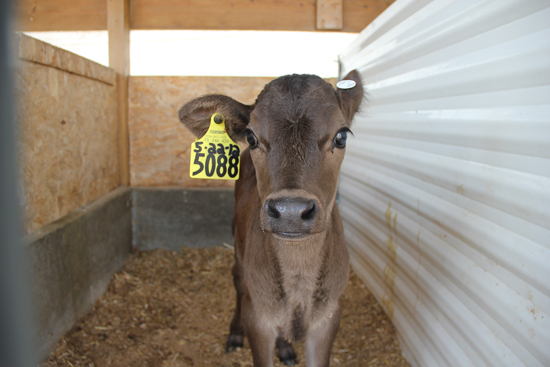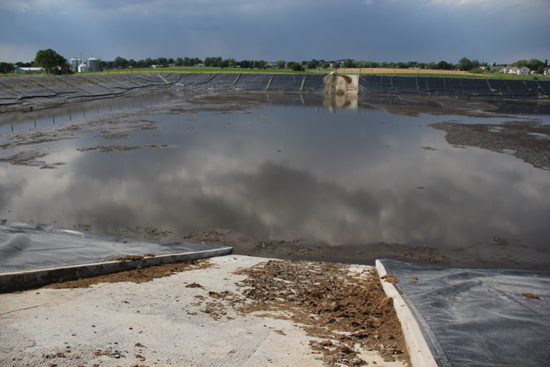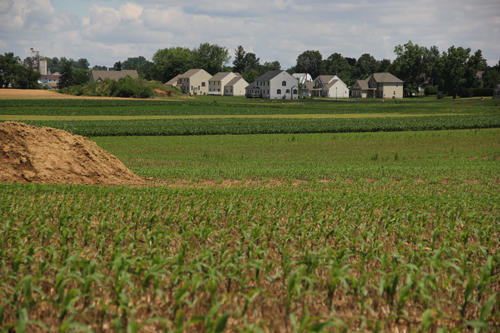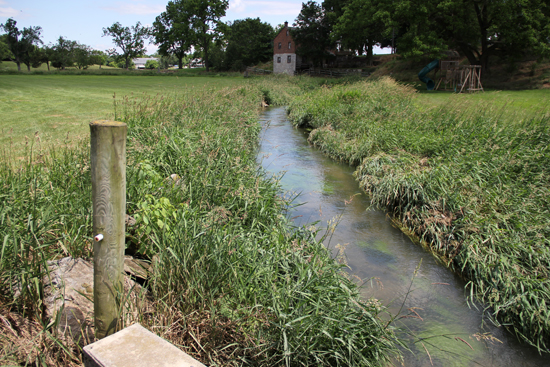Sustainable farming in Lancaster County, Pa.
Dairy farmer Luke Brubaker's sustainable agriculture practices ensures his land will stay in the family for generations to come.
Luke Brubaker lives in the house his father bought in 1929. His grandchildren play in the same creeks he played in as a child, and he farms the same land that his father farmed. But Luke's land in Lancaster County, Pennsylvania, has changed drastically since the days of his father; it is under pressure from higher rates of development (the large housing development at the edge of his property is one example); there is an increased use of pesticides, auto exhaust, and other chemicals that can leak into his groundwater; and a decrease in the amount of forested land allows nutrients from soil and bacteria from animal manure to easily run off into waterways instead of being absorbed by trees.
As Brubaker's land has changed, so has the agriculture industry; soaring energy and production costs and a plethora of environmental regulations mean that selling a gallon of milk isn't as easy as it used to be.
Nevertheless, Luke treats his land in a way that recognizes its vulnerability, farming it in a way that ensures it will be fertile in the future. His mindful practices have awarded him with productive land and healthy cattle, as well as a U.S. Dairy Sustainability Award, a Center for Advanced Energy Studies/Idaho National Laboratory Award for “Outstanding Achievement in Energy," and recognition as 2011 Innovative Dairy Farmer of the Year.
"I hope that this land will not only be preserved for farming," explains Luke, "but that the soils will be preserved on the land so that my grandkids can farm this, so that this can be food for the future."
Luke has grown his father's 18-cow dairy farm to a 900-cow operation, and hopes to keep the business in the family. Because he cares about the longevity of his land, he is concerned less with the quantity of milk he produces, and is instead concentrated on the reuse of energy and the quality of his products.
And while many farmers say that new regulations threaten their financial stability, Luke insists that following and exceeding these guidelines have helped him save money and keep his land in good health for future generations.
"It's an economic value to keep the water on the field, and keep the nutrients on the field, so it only makes sense to do good conservation practices," explains Luke. "This is what’s so important: that farmers realize the economic value of conservation practices, rather than doing it because they have to do it. And sometimes over the years, it has taken me time to realize that some of the old ways that we used to have aren’t the best ways."
On my tour of Brubaker Farm, the relationship between Luke's conservation ethic and economic good sense becomes obvious; the farm reuses everything and anything possible, especially cow manure!

"The more land that we can preserve and farm properly, the more soil we're going to have; we're going to be able to grow the food of our nation. That's very important to me," says Luke. "There's a great livelihood that can be achieved from good agricultural practices."
But what are "good" agricultural practices? Here are a few that are being implemented on Brubaker Farm:
Power in poop
At Brubaker Farm, the cows are kept in an open-air, temperature-controlled, shelter where they are able to roam from building to building. Their bedding is replaced regularly to keep them comfortable, and their feed, most of which is grown on the farm, is calculated to the tee.
"Our cows are fed probably better than some of our families are fed because we measure and weigh every bit of feed so they get the right nutrition," says Luke.
The cow's manure is swept away from the shelter every few hours. This differs from "free range" farms, where cattle are permitted to roam (and even sometimes, poop) where they please. The advantage of keeping the cattle in a controlled environment is that cows can remain cool in the summertime (they prefer cooler temperatures), and their manure is not laying around somewhere in the grass, or even worse, in a stream.
In fact, Brubaker understands his cow's manure to be just as valuable as the milk they produce. After an automatic cleaner collects manure from the cattle shelters, the manure goes into a machine called a "digester," which converts manure into methane gas that can be used (and sold) as an energy source.
On the Brubaker Farm, the solid manure wastes are converted into bedding for the cows. After it goes through the digester, it is pathogen free, making it the perfect, safe option for keeping cows comfortable.

The liquid manure is converted into electricity. Luke sells enough electricity to power 200 homes. The rest he reclaims as energy to fuel his farm's operations; the electricity is used to heat and pasteurize the milk before it is taken off the property, and to clean the cows’ towels (each cow gets his or her own cleaning towel!)
Luke is in the process is making a solar hot water system so he can make his own hot water from the farm's solar panels, which now provide electricity to 100 homes at peak sun.
The Brubaker's creative use of excess poop/energy has opened a whole new market to the family; in a recent year, they generated more profit from selling electricity than from selling milk!
No till farming
In his 1943 book, Plowman's Folly, Edward H. Faulkner said, "the truth is that no one has ever advanced a scientific reasoning for plowing." Yet, tilling soil is still protocol for many farms.
Traditionally, soil is loosened by a plow, or tilled, so that oxygen, water, and nutrients can reach the area where a crop's roots grow. Today, tilling requires the use of heavy machinery, which requires both fuel and labor to operate.
When heavy rain falls on a tilled field, loose soil is conveyed into nearby waterways, polluting the water with large amounts of nutrients and sediment.
When the soil is left in place, it is able to maintain its structure and better hold water. Not tilling the soil cuts back on fuel and labor costs. It also means that the soil is not loosened, and is therefore not as prone to erosion.
"After you no till for a couple of years, your soil gets roots," explains Luke. "It’s kind of like a sponge, and it allows the water to permeate into that sponge and holds it there. If you have a dry year, you’re going to have a better crop, because it holds that moisture there just like a sponge."

Cover crops
"Cover crops" are vegetation that holds the soil in place with its roots, preventing erosion even when a commercial crop is not being grown.
Cover crops shade the soil, preventing sunlight from fueling fast-growing weeds, and keeping the soil cool. Cover crops also discharge excess organic materials into the soil through their roots. These materials provide food for soil microbes and replenish nutrients that a future commercial crop, will benefit from.
If a field is fertilized heavily, cover crops can take up any excess fertilizer that was not used by a commercial crop; this will decrease the amount of nutrient pollution leaching into the groundwater and nearby streams.
Protecting streams
A stream on Brubaker's property is a favorite swimming hole for his grandchildren, and a favorite habitat for brook trout. Luke usually keeps his cattle in a controlled environment because keeping cattle away from this stream minimizes the sediment and bacteria pollution going into the waterway.
"One of the best things that small farms can do is to keep their cattle out of the streams," says Luke. "If the cattle have access to the whole stream and banks, they have a tendency to break the shores down, and that’s what causes sediment (pollution). We have fences to keep the cattle out so they aren’t breaking the banks of the stream."
Stream bank fencing also prevents rainwater, and the nutrients it carries, from ending up in waterways. Keeping these products on the field, instead of in the waterways, is not only beneficial to wildlife and plants, but to the farmer himself- it means more nutrients and water stay in place to fuel crop growth!
On Brubaker's farms, streamside trees (known as forest buffers) shade the stream, keeping it cool enough for trout. The tree's roots that stabilize stream banks and absorb any nutrients before they end up in the stream.
"It’s important for somebody else that the streams are clean, but it’s important for us (farmers) that our nutrients and water are on our fields," says Luke. "We know that when we have a clean stream, we know that our nutrients and our water are staying on our fields like they’re supposed to.

Learn more about sustainable agriculture in the Chesapeake Bay watershed:
- Luke and other farmers involved in United States Department of Agriculture's Conservation Reserve Enhancement Program (CREP) benefit from cost-effective conservation practices and technical assistance.
- Learn more about the benefits and disadvantages of no till farming from Mother Earth News and Northern Virginia Soil and Water Conservation District.
- Learn how Maryland farmers are being financially awarded for using cover crops on their fields.

Comments
Thanks For the Information! Archipley’s Family Farm, Inc. (AFFI) has partnered with the College of the Extended University at Cal Poly Pomona to create a one-of-a-kind agricultural program
Thank you, Peter. Glad you enjoyed it!
Greatly appreciated story on regional farming and the evolution of that particular farm. Good info.
Thank you!
Your comment has been received. Before it can be published, the comment will be reviewed by our team to ensure it adheres with our rules of engagement.
Back to recent stories